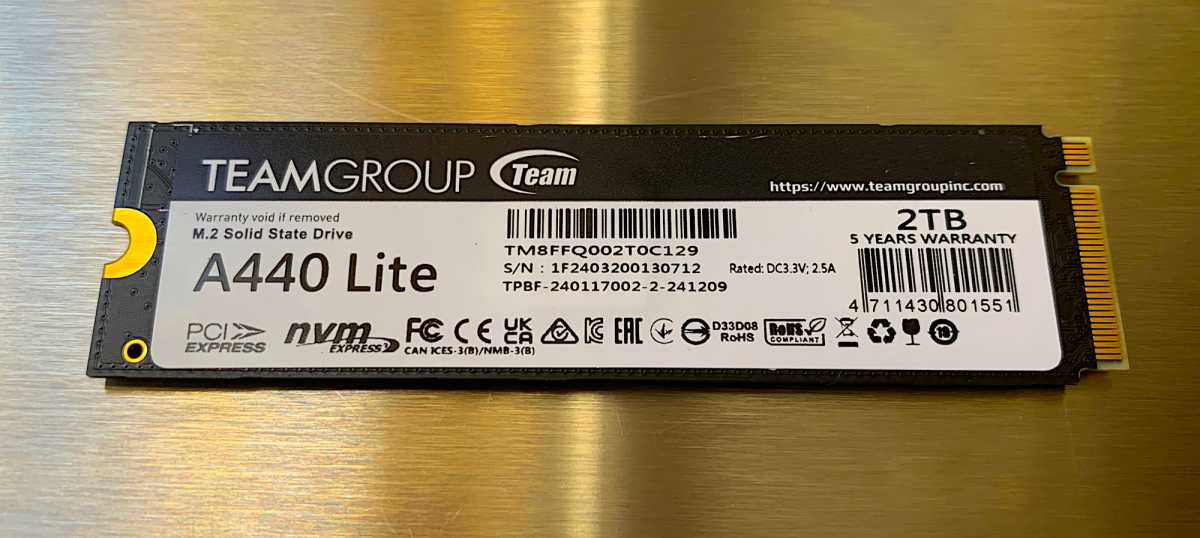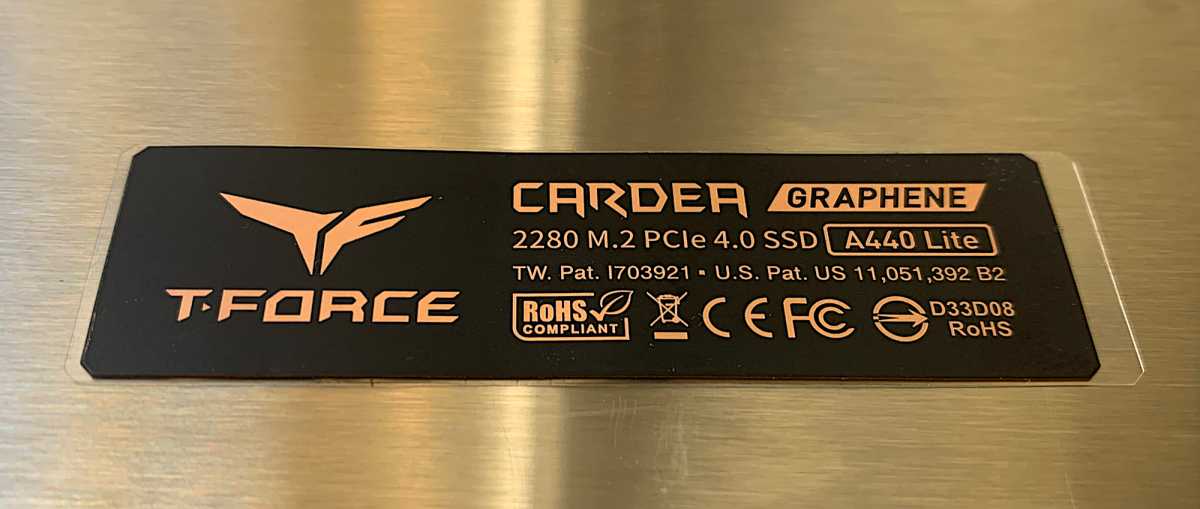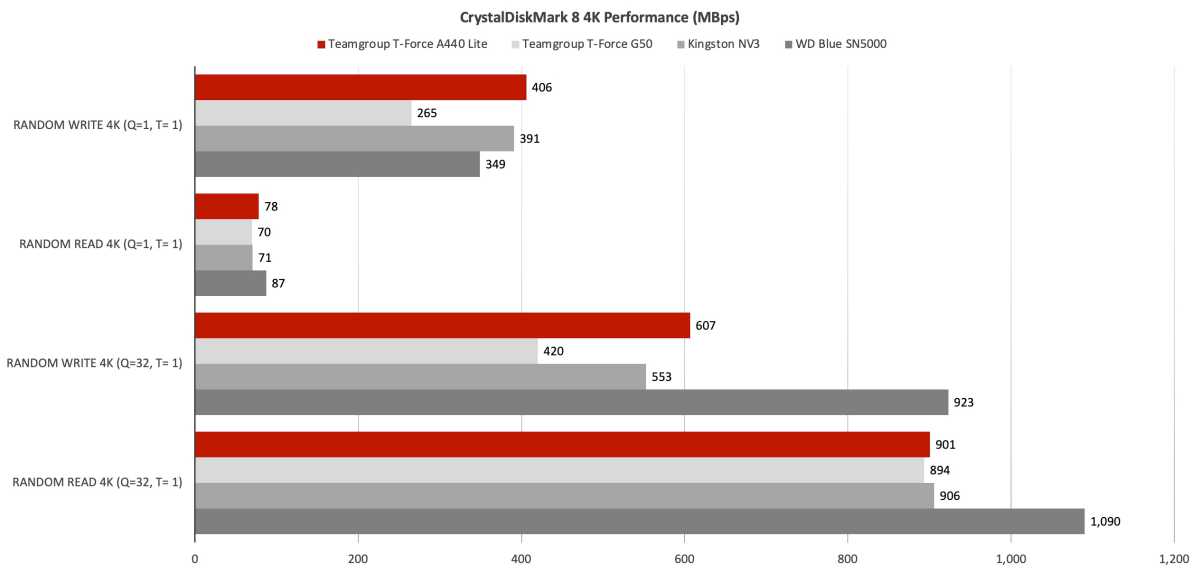Expert’s Rating
Pros
- Decent everyday performance
- Decently priced
- Handsome graphene heat spreader
Cons
- Slowed early during our 450GB write
- Lackluster performance compared to other HMB designs
Our Verdict
The A440 Lite has somewhat better synthetic benchmark numbers, but was slower than its cheaper G50 cousin in our real-world tests. I recommend the latter as the better budget SSD option.
Price When Reviewed
This value will show the geolocated pricing text for product undefined
Best Pricing Today
$69.99
Price When Reviewed
1TB: $70 I 2TB: $130
Best Prices Today: Teamgroup T-Force A440 Lite SSD
$69.99
To be honest, I was expecting more from the Teamgroup T-Force A440 Lite, as its Cardea 440 Pro cousin and partial namesake was a barn burner.
The A440 Lite on the other hand, while turning in better synthetic benchmark numbers than the recently reviewed, and extremely affordable T-Force G50, didn’t match the latter in our real-world transfers.
What are the Teamgroup T-Force A440 Lite’s features?
The T-Force A440 Lite is a 2280 (22mm wide, 80mm long), PCIe 4.0 x4, M.2 NVMe SSD with 162-layer TLC NAND using a Phison PS5027-E27 controller. It’s a host memory buffer (HMB/DRAM-less) design that relies on a device’s system memory to perform primary caching duties.
Overall, HMB designs, at least modern ones, rock in sequential transfers, but lag somewhat in random ops compared to DRAM models.

Teamgroup warranties the A440 Lite for five years, which will be abrogated if you write more than 600 terabytes per 1TB of capacity to the drive. This is what’s known in the biz as a 600TBW (terabytes that may be written) rating.
Further reading: See our roundup of the best PCIe 4.0 SSDs to learn about competing products.
How much does the A440 Lite cost?
Teamgroup sells the 1TB A440 Lite for $70 and the 2TB capacity for $130. That’s $10 more in each capacity than the recently reviewed G50, but you do get better performance in synthetic benchmarks and random ops. That said, the G50 set a record for writing our 450GB file — nothing to sneeze at.

A 512GB capacity was listed in our vendor fact check sheet, but was not available or priced as of the time of this writing.
How fast is the A440 Lite?
Alas, the 440 Lite was slower than most of its host memory bus/TLC NAND competition — finishing 14th out of the 21 such drives I’ve tested to date. HMB drives fall under the budget category. This discussion, of course, comes with the standard disclaimer that all NVMe SSDs are hella’ fast — we’re basically comparing F1 cars here.
That said, you can see that the A440 Lite’s CrystalDiskMark 8 numbers, while better than its T-Force G50 cousin, weren’t up to the stiffer competition from the Kingston NV3 or the WD Blue SN5000 — our current top PCIe 4.0 budget pick.

Again, the A440 Lite outpaced the G50, and in this case, even the other drives in the first single-queue test. Note that most software, including Windows uses only a single queue.

Though not a slouch at our 48GB transfers, the A440 Lite did lag just a bit behind its competitors.

The 450GB write is the test that had me thinking, “Why pay $10 more for the A440 Lite when the Teamgroup G50 sustains long writes better?” Of course, few users write 450GB file regularly.

Middling performance is our takeaway from our time with the A440 Lite. Not bad, but not great either.
Should you buy the A440 Lite?
If you find the A440 Lite for a significantly lower price than the competition, perhaps. But the drive is merely a ho-hum performer overall. In other words, you can probably do better, including with Teamgroup’s own T-Force G50 — an outstandingly affordable SSD.
How we test
Drive tests currently utilize Windows 11, 64-bit running on an X790 (PCIe 4.0/5.0) motherboard/i5-12400 CPU combo with two Kingston Fury 32GB DDR5 4800MHz modules (64GB of memory total). Both 20Gbps USB and Thunderbolt 4 are integrated to the back panel and Intel CPU/GPU graphics are used. The 48GB transfer tests utilize an ImDisk RAM disk taking up 58GB of the 64GB of total memory. The 450GB file is transferred from a 2TB Samsung 990 Pro which also runs the OS.
Each test is performed on a newly formatted and TRIM’d drive so the results are optimal. Note that in normal use, as a drive fills up, performance may decrease due to less NAND for secondary caching, as well as other factors. This can be less of a factor with the current crop of SSDs with far faster late-generation NAND.
Caveat: The performance numbers shown apply only to the drive we were shipped and to the capacity tested. SSD performance can and will vary by capacity due to more or fewer chips to shotgun reads/writes across and the amount of NAND available for secondary caching. Vendors also occasionally swap components. If you ever notice a large discrepancy between the performance you experience and that which we report, by all means, let us know.


